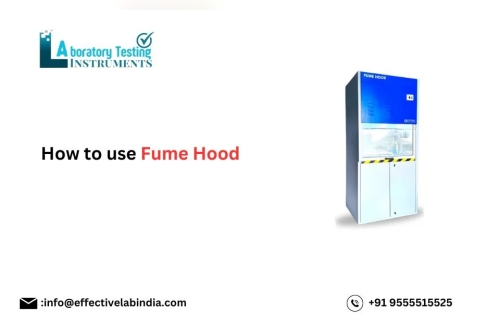Fume hoods are specially designed ventilation units to protect lab workers from dangerous gases, chemicals, and fumes. By removing air from the work area and either filtering or releasing it outside, these hoods are intended to keep lab personnel safe. In labs where scientists, researchers, or students deal with chemicals that might be harmful if inhaled or come into touch with skin, fume hoods are vital safety equipment.Industries like rubber, automotive, and pharmaceutical use laboratory testing instruments
Why are Fume Hood Important?Fume hoods are essential for the safety of lab employees. When working with chemicals, particularly ones that release harmful gases, you run the risk of breathing in harmful materials. Inhaling such gases can cause health issues that range from minor discomfort to serious lung damage. Chronic ailments can also develop with long-term exposure. The purpose of the fume hood is to remove and capture dangerous gases before they have a chance to enter the room and cause harm.
How Do Fume Hood Work?The fume hood is similar to a protective box with an opening, or front window or panel, on it. The fume hood draws the air and any fumes away from you, but you can still reach inside to work with your chemicals when the door is opened. An exhaust system, which either vents the air outside or filters it before recirculating it, is what forces the stream of air that is created inside the hood by fans from the lab.
The airflow is essential to the fume hood’s efficiency. The lab worker and the dangerous substances are separated from each other by the airflow. The fumes will be drawn away from the user so they are not exposed as long as the airflow is kept at a safe level.
Different Types of Fume HoodsFume hoods come in a variety of styles, each with a distinct function. Based on the substances you are dealing with and the necessary level of protection, select the appropriate type of fume hood
1. Fume Hoods with DuctsThese fume hoods are the most widely used kind. Contaminated air in a ducted fume hood is drawn through the hood and released through ducts outside the structure. When working with corrosive, hazardous, or combustible substances that shouldn’t be recirculated into the space, this kind of fume hood is perfect.
2. Fume Hoods without ducts
Ductless fume hoods do not exhaust air outdoors, in contrast with ducted hoods. Rather, they pass the air through a number of filters before introducing it into the laboratory. Because the filters in these hoods must be capable of efficiently trapping any toxic compounds, they are most appropriate for less hazardous materials. Compared to ducted hoods, ductless fume hoods are frequently easier to install and use less energy.
3. Biological Safety CabinetsBiological safety cabinets (BSCs), while not exactly fume hoods, work similarly by managing airflow to safeguard workers and the items they handle. When working with biological agents, such as bacteria or viruses, these cabinets are utilised. They shield the sample from contamination while also protecting the worker.
Walk-In Fume HoodsThese are larger fume hoods, as the name implies, that the user can walk within. They are designed for use in larger-than-standard fume hood experiments or equipment. Specialized or industrial research facilities, where large-scale experimentation typically occurs, house these laboratories.
Key Parts of a Fume Hood
Biological safety cabinets (BSCs), while not exactly fume hoods, work similarly by managing airflow to safeguard workers and the items they handle. When working with biological agents, such as bacteria or viruses, these cabinets are utilized. They shield the sample from contamination while also protecting the worker.
Walk-In Fume Hoods
These are larger fume hoods, as the name implies, that the user can walk within. They are intended for use with larger-than-standard fume hood experiments or equipment. Large-scale experimentation is typically carried out in specialized or industrial research facilities, which are home to these hoods.
Important Fume Hood ComponentsSeveral components of a fume hood cooperate to ensure the safety of the lab:
Sash is usually composed of glass, which is the transparent panel located at the front of the hood. It is movable, allowing you to reach the work area within the hood. Maintaining a low sash enhances safety.
Work Surface: This is the area where your lab supplies and chemicals are kept. Typically, the surface is composed of materials that are resistant to heat, chemicals, and corrosion.
The airflow system forces the hood’s inside to be under negative pressure. It draws the tainted air into the hood and out of the direction of the worker.
Exhaust System: After being brought into the fume hood, the air is either filtered and circulated (in a ductless hood) or vented outside the building (in a ducted hood). This mechanism makes sure that dangerous substances don’t get into the lab’s air supply.
The Best Ways to Use a Fume HoodIt’s important to use a fume hood correctly if you want to optimise its protective benefits. Here are a few easy pointers to remember:
1. Don’t Overdo the SashWork with the sash as low as you can at all times. This enhances the hood’s capacity to extract fumes while creating a wall between you and the chemicals. Fumes may escape into the lab if the sash is too high.
2. Don’t Fill the Work Area Too MuchSteer clear of packing the fume hood with an excessive amount of chemicals or equipment at once. Overloading the work area can obstruct airflow and reduce its effectiveness. Always place larger items toward the back of the hood to maintain clear airflow.
3. Proceed GraduallyThe airflow might be disrupted by moving too quickly in the work area or in front of the hood. Aim to operate steadily; abrupt motions could force fumes out of the hood.
4. Put on personal defense gear (PPE)You should wear the proper personal protective equipment (PPE), such as lab coats, gloves, and safety goggles, even if the fume hood provides protection, to further lower your risk of exposure.
5. Consistently Check the AirflowMost fume hoods contain an airflow monitor or alarm that informs you if the airflow falls below safe limits. Make sure to check this frequently, and if something isn’t working right, don’t use the fume hood.
6. Preserve the HoodTo guarantee that the fume hood functions properly, regular maintenance is essential. To ensure the hood functions properly, schedule regular professional inspections and tests. In ductless hoods, change the filters according to the manufacturer’s recommendations.
In summaryAny laboratory that works with potentially dangerous chemicals or materials needs fume hoods.
By absorbing and removing dangerous gases, fumes, and dust, they offer vital protection and guarantee the security of lab personnel. You can make the lab environment safer and more productive for all parties involved by adhering to best practices, operating the fume hood correctly, and doing routine maintenance.
















